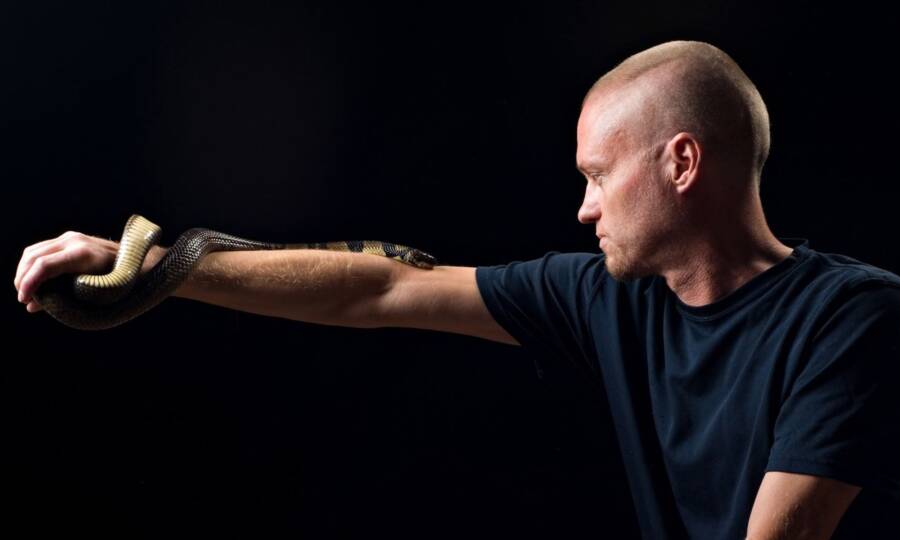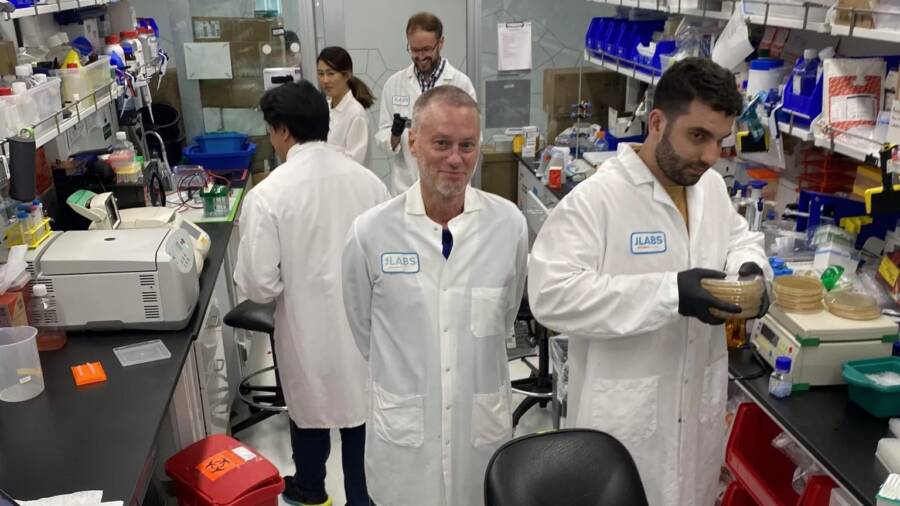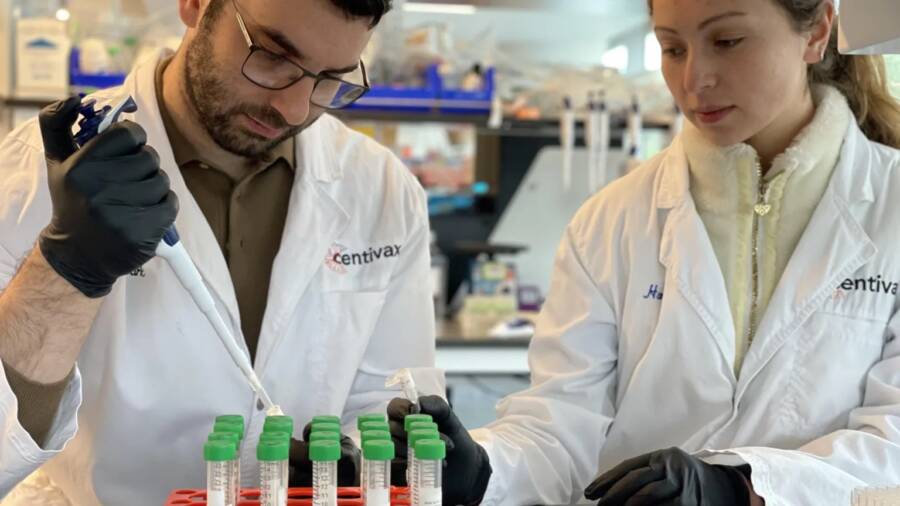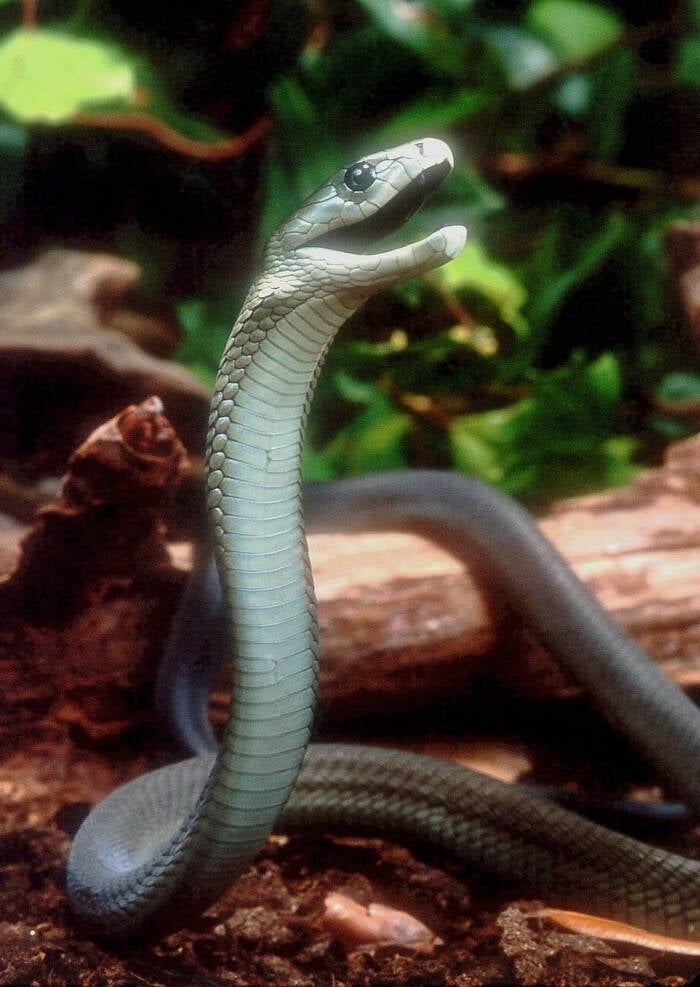Tim Friede has subjected himself to more than 700 doses of lethal snake venom and 200 actual snakebites over the past two decades. Now, his antibodies may lead to a universal antivenom.

CentivaxTim Friede with a water cobra.
For the past two decades, a man named Tim Friede has been self-administering doses of venom from cobras, mambas, rattlesnakes, and other deadly species with the hope of developing immunity to snakebites and helping scientists create a universal antivenom.
Friede administered most of these venoms via injection, but he also let venomous snakes bite him more than 200 times in the pursuit of this potential remedy — and it seems his sacrifice has paid off. Researchers have now used Friede’s antibodies to create a broad antivenom that has proven successful in mice.
According to a new study published in the journal Cell, that antivenom was able to partially or fully neutralize the venom of 19 of the world’s deadliest snakes, including the black mamba, king cobra, and taipan. While researchers said human tests are likely two years away, the results are nevertheless staggering.
Tim Friede’s Quest To Create A Universal Antivenom

Jacob GlanvilleTim Friede (center) with researchers at Centivax.
Most people would be right in assuming that Tim Friede’s obsession is dangerous. But for Friede, the end goal is worth the risk.
As he explained to the BBC, he first started this journey because he wanted to build up his immunity for protection while handling snakes. But Friede, a former truck mechanic, said he “completely screwed up” early on when he fell into a coma thanks to two cobra bites in quick succession.
“I didn’t want to die,” Friede said. “I didn’t want to lose a finger. I didn’t want to miss work.”
After that, he said, “it just became a lifestyle and I just kept pushing and pushing and pushing as hard as I could push — for the people who are 8,000 miles away from me who die from snakebites.”
Friede grew up in Milwaukee and spent a lot of time as a kid “herping,” or searching for snakes. As he told The Washington Post, a bite from a harmless garter snake when he was five years old ignited a lifelong curiosity with snakes and their venom.
Over the course of the last two decades, Friede has documented his exploits via his YouTube channel. He imported venomous snakes from around the world and began milking them — along with scorpions — for their venom. He then heavily diluted that venom and injected himself with it, gradually increasing the dosage to bolster his immunity.
“I was more concerned about protecting myself and surviving first,” he said. “And then I realized that I’m beating death, and it’s great, but how do you get it out to the rest of the world?”
How Tim Friede Joined Forces With Scientists

Jacob GlanvilleResearchers using Friede’s antibodies to develop the antivenom.
Snakebites claim the lives of an estimated 140,000 people per year and leave three times as many facing amputation or permanent disability. To make matters worse, most deadly snakebites occur in poor nations, meaning there has been little economic incentive for institutions to create snake-specific antivenom.
“The market’s fractured into 30 to 40 products, which makes it really tiny markets, which are not attractive to innovation,” explained study co-author and Centivax CEO Jacob Glanville. “For that reason, antivenom hasn’t really changed in the last 125 years.”
But even with some antivenom on the market, patients often don’t know which species of snake bit them. Antivenom can also be less effective outside the region where the original venom was created due to genetic differences in snake populations. The only real solution would be a universal antivenom, but until recently, no one had attempted to make one.
It’s not an impossible task, either. There may be some 600 venomous snake species out there, but their venoms all contain different combinations of just 10 core toxin types. If a universal antivenom could target those toxins, then it just might work.
So, when Glanville heard that a man in Wisconsin named Tim Friede had already done a good portion of the legwork, he decided to get in touch with him.
“Immediately I was like, ‘If anybody in the world has developed these broadly neutralizing bodies, it’s going to be him,’ and so I reached out,” Glanville said. “The first call, I was like, ‘This might be awkward, but I’d love to get my hands on some of your blood.'”

Bill Love/Blue Chameleon Ventures/Wikimedia CommonsA black mamba, one of the deadliest snakes in the world.
Friede responded, “I’ve been waiting years for this phone call.”
Since the researchers were only going to be taking Friede’s blood and not administering more venom, the project was given ethical approval. Two years later, Glanville met structural biologist and vaccine researcher Peter Kwong at a Gates Foundation dinner, and they quickly realized they shared an interest in developing the antivenom.
“He was interested in my technology,” Kwong said. “I was interested in the antibodies that he had pulled out.”
Together, they got to work. They picked 19 elapids (a specific family of venomous snakes) identified by the World Health Organization as being among the deadliest snakes on the planet and then worked to pull antibodies from Friede’s blood to neutralize two classes of neurotoxins. In combination with a molecule that could target a third, they created their antivenom cocktail.
They tested the cocktail on mice, finding that the animals survived doses from 13 of the 19 species of venomous snakes, with partial protection against the remaining six.
“These are the most poisonous elapids out there that kill horses, and we can handle 13 of them,” Kwong said.
Glanville said that this is an “unparalleled” breadth of protection, and that it “likely covers a whole bunch of elapids for which there is no current antivenom.”
While they are still working to refine the antibodies further and identify a fourth component that could lead to total protection, the research shows that it could one day be possible. Kwong estimates that it could even happen in “the next 10 or 15 years.”
“It’s an overwhelming feeling knowing that what I’m doing someday can change — it already has — medical history,” said Friede.
After reading about Tim Friede’s quest to create a universal antivenom, meet the Titanoboa, the prehistoric snake that grew up to 50 feet long. Then, read about some of history’s most shocking Frankenstein-like experiments carried out by some truly mad scientists.





